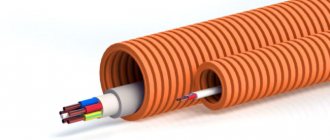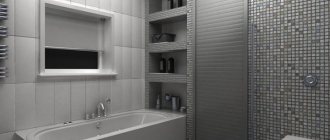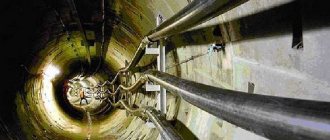General classification of electrical wiring
According to the above GOST definition, electrical wiring consists of a cable system (wires and cables), a protection system and a fastening system.
Therefore, the general classification of electrical wiring can be presented as follows:
According to the design features of the cable system
Depending on the type of electrically conductive material used in the cable, electrical wiring can be:
- aluminum,
- copper.
Based on the number of strands of electrically conductive material, electrical wiring is divided into:
- single-core,
- stranded.
According to the location of the cable system
- internal,
- external.
By cable laying method
- open,
- hidden.
According to the design features of electrical wiring in general
Depending on the number of phases used, electrical wiring can be:
- single-phase (220 V),
- three-phase (380 V).
Based on the presence of a grounding loop, electrical wiring is divided into:
- Without ground loop (two-wire),
- With grounding circuit (three-wire).
According to design, starting from the input panel, electrical wiring is classified:
- Ring (series) (a closed circuit supplies all lighting, electrical appliances and sockets within one apartment or building, the area of which should not be more than 100 m2),
- Daisy chain (parallel) (the cable is laid to one point, from which the power supply is then transferred to the neighboring one),
- Radial (“star”) (a separate cable is laid to any lighting group, group of sockets and electrical appliance, which allows you to connect powerful electrical appliances in a safer way),
- Dose (distribution) box (the cable from the panel is laid on distribution boxes, from which one wire goes to the switch and cartridge).
Let's consider the most common combinations of types of electrical wiring in practice.
Types of electrical wiring and methods of their installation
There are 3 types of electrical wiring installation, regardless of the cable laying conditions: open, closed and combined. The simplest installation method is open wiring. It is convenient in that it allows you to easily change and add cables to common nodes; any section of it is easily accessible for repairs and connecting new pantographs. In this case, there is no need to hammer into the walls in case of cable damage and the cause is eliminated, as with closed wiring. Typically, open cabling is used in office spaces, where new cables and wires often need to be laid. The disadvantage of this method is its low aesthetics, and therefore open wiring in residential premises is very rarely carried out. However, in the individual residential sector, in the country house and in utility rooms, it is used quite often, especially since there are modern ways to solve aesthetics. Stores sell baseboards with cable channels, or you can purchase special PVC cable channels for any cable cross-section.
Laying electrical wires in protective channels is carried out in two ways:
- Gasket with special fittings. With this method of installing open electrical wiring, special fittings are used, designed for the installation of electrical installation devices (switches and sockets), or a gasket with special fittings (insulation box system). Corners, bends, and separation of wires in the shape of the letter “T” are performed using fittings that allow you to correct errors and uneven walls. This method makes it easier to lay electrical wires and provide reliable protection from mechanical damage.
- Gasket without special fittings . In this case, changing the direction of the wire (angles) is done by cutting the boxes at an angle of 45 °. It must be remembered that the cuts are made carefully, with great care, without leaving any gap between the connections. This should provide the electrical wires with reliable protection. Installation without special fittings is possible only with minor updating of the electrical wiring.
This method of updating electrical wiring is suitable for quick implementation, does not cause significant damage, and is reliable. But the electrical wiring remains visible.
Open wiring of flat wires such as APR, APPV, APRV on combustible bases is carried out over a layer of sheet asbestos with a thickness of at least 3 mm, protruding from each side of the wire by at least 5 mm.
Asbestos gaskets are secured before the installation of wires with nails every 200 - 250 mm in a checkerboard pattern. When laying several groups of wires, the strip can be common, taking into account the distance between the wires of each group of at least 5 mm. To fasten the wires, strips of tin 10 mm wide and 0.3 - 0.5 mm thick are used, attached over a layer of asbestos. Between the metal strip and the wire, a gasket is placed from electrical insulating cardboard, protruding beyond the edges of the strip by 1.5-2 mm. When fastening the wire, the metal strip with the gasket should tightly grip the surface of the pre-tensioned wire. Bending flat wires in corners is performed by first cutting out the separating film between the wires at a length of 40-60 mm and taking them inside the corner (see figure).
Today, plastic products are sold for sale, designed for fastening flat wires of various cross-sections. They can replace tin strips. The convenience of using plastic clamps is that they can be secured with BMK-5K glue and nails.
In addition, the ends of the wires inserted into branch boxes or into boxes of installation devices are cut off with a margin of approximately 65-75 mm, which makes it possible to reconnect the cores and conveniently replace the socket or switch. The wires are inserted into the box so that the section of the dividing base cut into them does not come out of the box. The wire strands are connected in boxes; the exposed ends of the strands must be insulated with adhesive tape. The insulated ends of the wires are placed in boxes so that they do not touch each other. The ends of the wires at the entrance to the box are fixed on the wall at a distance of 50mm from the box.
Closed wiring is considered the safest and is often used in residential areas. Its main drawback is the difficulty of accessing the wires. The cables are installed in hollowed-out grooves directly in the walls, and after laying the wires, these places are tightly cemented. Flat wires in walls, grooves or beards are fixed using the “freezing” method with alabaster. They can also be secured with special plastic clamps. Fastening wires with nails is strictly prohibited! Hidden wiring is the most common and safe to use, since it is located in the thickness of fireproof material (there are no mechanical impacts, air access to it is difficult). When laying under plaster on a wooden wall, a 3mm layer of asbestos is placed under the wires. Crossing flat wires with each other should be avoided. If crossing is necessary, the insulation of the wires in this place is reinforced with three to four layers of electrical tape. Hidden wires are brought to the surface of the ceiling walls (for connection to lamps) through insulating tubes or plastic tubes. When wiring is hidden, it is allowed to make branches of flat wires in the input boxes of switches, sockets or lamps.
If electrical wiring is carried out under a layer of drywall, then there is no need to punch grooves in the drywall. Since the gypsum board is mounted on the wall on a special profile, there is a void between the sheet itself and the base. In this case, it will be enough to drill several holes (30 to 40 mm in diameter) in the drywall along the route of the electrical wiring. Wire loops are pushed through the holes, with the help of which the wires are pulled from the reverse side. When repairing wiring, a faulty wire is often used as a conductor.
Combined wiring presupposes the application of the same rules and fastening of the complete set of devices for the construction of electrical wiring. This installation method is used in rare cases and is more complex in terms of implementation.
When updating electrical wiring, professionals usually use this method. Its essence is as follows: a combination of laying electrical wires in insulating boxes and in walls in a hidden way. Parts of exposed electrical wiring that look unaesthetic, for example, to power a lighting fixture, are done in a hidden way. In this case, insulating boxes are placed above the baseboards, around the door frames, and on top - along the junction lines of the ceiling and walls. All other wire branches are hidden.
After electrical installation work, the final appearance of the room is quite presentable. Upon completion of painting, the insulation boxes are almost invisible against the background of the wall. This method of electrical wiring meets the standards in force for the installation of wires in walls and partitions, because gating is partially used.
It is useful to know about typical designs and twisted pair cables.
Hidden internal wiring
This type of electrical wiring is usually used in apartment buildings or cottages.
Installation of hidden internal electrical wiring is carried out in different ways:
- Installation in technological openings of building structures (for example, in panels of apartment buildings),
- Installation in grooves under plaster (the most common option),
- Installation under suspended and suspended ceilings and structures,
- Installation under plastic panels,
- Installation in cable ducts, corrugated pipes, metal hoses located inside structures,
- Installation directly into the floor.
Types of electrical wiring in industrial premises.
- home
- All articles
- Types of electrical wiring in industrial premises.
/
/
Wire and cable, as well as supporting protective structures related to them, fastenings with various elements, all this is electrical wiring. According to the PUE, this name also applies to the electrical wiring of lighting, secondary, and power circuits up to 1000 W.
They have direct and alternating current, fixed inside buildings and structures, on external walls, factories, institutions, enterprise organizations, using insulated cables of any conductors, as well as unprotected power wiring in a plastic or rubber cover with conductors up to 16 kV/mm. Electrical wiring that is installed on the surfaces of ceilings, walls, buildings, structures, supports, etc. usually called open. Electrical wiring that is laid inside structures (in foundations, walls, ceilings, floors), various buildings, and structural elements is called hidden. For installation in structures, including explosive ones, AVBbShv cable is used. Electrical wiring that is laid externally along the walls of structures, buildings, as well as between houses on supports (no more than 3 runs and 20 m long each span) is called external. Electrical wiring, which is attached using a steel wire stretched close to the surface of the ceiling of a room, the wall of a building, etc., is called a string. Electrical wiring that is attached using a steel strip mounted close to the plane of the ceiling, wall, etc., which serves to hook bundles of cables to it, is called a strip. A cable that holds electrical wiring is a steel rope or wire that is stretched in the air to hang a cable line, wiring or bundles of them from it. The box is a completely closed structure, which has a rectangular or other shape that is used for laying wiring or cable lines in it. The tray is an open structure that is used for laying wiring and cable lines in it. The tray does not protect wiring and cable lines from external mechanical factors. Electrical wiring of lighting and power networks is carried out only with insulation and winding. As a rule, for the installation of cable or string electrical wiring, a specific wire with a guide cable built into it and insulated conductors of any cross-section are used. String and cable wiring are used for the construction of distribution, group, main lighting and power routes in a 380 W AC network. It is recommended to use string and cable wiring primarily for constructing lighting networks. It is especially advisable to use them in networks for lighting closed or open areas, overpasses, galleries, open areas intended for transport, sports grounds, etc. Cable wiring is also used at manufacturing enterprises for laying power and lighting networks in workshops free from the movement of overhead cranes. In such electrical wiring, VVG power cable is used. String electrical wiring became widespread during the construction of electrical networks, both external and internal in livestock and agricultural production areas. The advantage of string and cable electrical wiring is their simplicity in design, not a huge number of mounting elements and the possibility of fastening at all marks, and, if necessary, moving it to a new location. String and cable wiring also differ from other types of wiring in the relatively small scale of labor-intensive punching work.
External electrical wiring
It is used when installing street lighting, supplying electricity to garden and country buildings (garage, bathhouse, outbuilding) or to the attic of a building.
External electrical wiring can be carried out in the following ways:
- Air laying between supports (cable or string wiring),
- Laying on the surface of buildings and structures,
- Underground installation (hidden wiring).
On a note!
To choose the most suitable cable laying method, you must be guided by the Electrical Installation Rules (ELR).
The choice is also influenced by environmental conditions (in attics, care must be taken to ensure reliable protection of the cable system from moisture, and in a wooden house, from fire).
External hidden electrical wiring
In urban conditions, due to limited space, the laying of open lines is carried out mainly only for the purpose of organizing street lighting, and all other electrical networks are located below ground level. The buildings are connected to each other through distribution substations via cable routes.
Cables are laid in special concrete gutters or metal pipes that reliably protect against moisture getting inside. Cable protection is provided by insulation made of polymer materials or artificial rubber, since with this installation method the main thing is to protect the terminals and cable from moisture, and not from light.
The cables mainly used are VRG (copper power cable in rubber insulation and PVC sheath) and AVRG (power aluminum cable in rubber insulation and PVC sheath).
Advice from experts
Wiring selection
Any electrical wiring in residential, public and industrial premises is usually a very complex system. Its reliability, safety and durability directly depend on the materials used and the trouble-free operation of absolutely all its components.
The type of electrical wiring and the method of its installation are selected based on the intended purpose of the structure and environmental conditions.
The first step is to make a wiring diagram for future wiring, taking into account the location of all energy consumers in the building and the maximum load on the network. It is also necessary to take into account the future purchase of electrical appliances with high energy consumption.
Electrical wiring components
To install an electrical network, wires and cables of different sections, fasteners (couplings, clamps, ties), connecting devices (clamps, terminals), supporting elements (cables, strings) and various protective structures (boxes, trays, sleeves, corrugations, pipes) are used and so on.).
The choice of protection directly depends on the location of the electrical wiring, humidity, the influence of temperature conditions, the presence of chemically active substances, dust, explosion and fire hazards in the premises.
Requirements for electrical wiring installation
Types of electrical wiring and methods of laying them are selected in accordance with the above-mentioned Electrical Installation Rules (PUE).
According to the PUE, all types of electrical wiring must comply with the following requirements:
- installation of electrical wiring is carried out according to a pre-drawn wiring diagram,
- switches, sockets, distribution boxes, panels and other elements of the electrical network must be located in easily accessible places,
- any electrically conductive elements must be insulated,
- laying of wires and cables is carried out strictly vertically or horizontally, no deviations are allowed,
- the cable system must be laid: horizontally at least 5–10 cm from beams and cornices, 20 cm from the ceiling and 15–20 cm from the floor level; the vertical distance from doorways, windows and corners must be at least 10 cm,
- electrical sockets must be located at least 30 cm from the floor and at least 50 cm from metal structures,
- switches are mounted at least 90 cm from the floor so that open doors do not block them,
- the distance between the wiring to be laid and the gas pipe must be at least 40 cm,
- in the immediate vicinity of a hot water supply, the cable is protected with an asbestos gasket,
- in kitchens of residential premises only closed type of electrical wiring can be used,
- wires and cables laid in boxes, pipes and trays are subject to mandatory marking,
- the type of electrical wiring must be selected taking into account the load on the electrical network while simultaneously turning on all existing electrical equipment.
Section
The cross-section is selected in accordance with the number of electricity consumers, taking into account possible voltage drops and losses at the wire connections. To calculate its area, you need to add up the power consumption of all electrical appliances in the room.
To avoid overheating of the cable system when all consumers are turned on at the same time, select a wire cross-section with a margin. The cross-sectional area of cables and wires should be 15–20% higher than the maximum permissible load.
Marking
In order to make it easier to identify the cable, its characteristics and scope of application, a cable identification or marking system was developed. Data is recorded in a certain order, each letter or number has its own meaning.
- The first letter is conductive material. "A" means aluminum is used. If the letter is missing, then the material used is copper,
- The second letter is the degree of flexibility. "G" - flexible, stranded. If the letter is missing, then the cable is single-core,
- The third letter is the insulation material. “B” – polyvinyl chloride (PVC), “P” – polyethylene, “P” – rubber, “NR” – non-flammable rubber, “F” – fluoroplastic, “C” – film insulation (for installation wires),
- The fourth letter is the shell material or armor type. "BBG" - armor made of steel profiled tape, "Bn" - armor made of steel tapes with a protective coating that does not support combustion, "B" - PVC, "D" - braided from a double wire, "K" - armor made of round steel wires , enclosed in a steel cover, “SB” - lead armor,
- Fifth letter - Type of protective cover, purpose of the outer layer, designation of the core structure. “B” - PVC (if at the end it means paper insulation), “G” - anti-corrosion protective layer (no “G” - no protection from mechanical damage), “O” - insulated wires are united by a common braid, “Shv” - protective layer - extruded PVC hose, "Shp" - protective layer - extruded polyethylene hose, "Shps" - the same, but polyethylene is self-extinguishing, "E" - shielded, "T" - wire for laying in pipes.
Also, the cable marking consists of several numbers, which are deciphered as follows: the first number is the number of cores, separated by an “x” sign, the second number is the cross-sectional area, the third number indicates the rated voltage in the network (for power cables). And the last thing that can be applied is the designation of the standard according to which this type of cable and wire product is manufactured.
Examples
- VVG cable - 2x1.5. It stands for: power cable sheathed in polyvinyl chloride (PVC). The shell is covered with an anti-corrosion layer. Consists of two copper wires with a cross section of 1.5mm2,
- Cable VBBShvng. The decoding of this abbreviation is as follows: copper conductors (there is no letter A). The core insulation is made of PVC, the BB armor is made of two steel strips, without a protective pad. Cable protective cover - Shvng - pressed-out PVC hose of low flammability,
- APvPu - aluminum conductors (A), insulation made of cross-linked polyethylene (Pv), reinforced sheath made of polyethylene (Pu).
The range of cable and wire products also includes wires. How are they different from cable? As a rule, they have a smaller cross-section.
When carrying out electrical installation work using a large number of types of wires and cables, marking tags are used indicating the functionality of each wire. These tags are attached to insulation or heat shrink near the point where the wiring is installed.
Colors of wires in the cable
The neutral wire is usually denoted in blue, grounding - alternating yellow and green. The phase wire is marked brown, red, purple, sometimes black or white, but never green or yellow, so as not to be confused with the ground wire.
Mounting methods
The cable system is attached to a solid surface or cables with special devices that hold it securely and do not allow it to sag.
With the open installation method, these are clips, staples, cable ducts, insulators and mounting pads.
For hidden fastening, clamps, dowel-clamps, dowel-ties, and PP dowels are used.
To lay cables and wires in difficult conditions, for example, on cables, special fastenings are used - hangers and ties.
The connection of wires can be made using clamps, terminals, PPE caps, welding and crimping with sleeves.
Security requirements
Regardless of the type of electrical wiring and how it is installed, adhere to the following safety requirements:
- Use only certified materials that meet all fire safety rules,
- It is mandatory to have a wiring diagram of the entire electrical network for quick access to all its elements in the event of an emergency,
- Use of three-core cables with mandatory grounding connection,
- Safe connections without twists,
- Availability of an automatic power shutdown system in case of malfunctions.
Compliance with all safety standards and requirements will help protect premises from possible fires and other problems.
Materials kindly provided
For any questions you can contact:
Internal electrical wiring
There are three types of internal wiring
- Hidden. Such wiring is carried out under the decorative covering of walls and floors. Used in residential areas.
- Open. Layed directly on the surface of structures. It can be enclosed in special shells or left without them.
- Combined. Most often used in corridors and utility rooms. The combined type includes openness of access and at the same time fire safety.
Indoor wiring is used to supply electricity to buildings. When installing, you must follow the rules.
- Provide open access to metering equipment and distribution boxes, switches and sockets.
- Switches must be installed at a distance of 60-150 cm from the floor.
- Sockets are located at a height of 50-80 cm from the floor.
- A safe distance of 50 cm must be maintained between the socket and the gas stove, heating radiator and pipes.
- The number of sockets is calculated based on the area of the room. One piece for every 6 sq.m. In the kitchen, the number of sockets corresponds to the number of household appliances.
- When installing the cable closed, it should be laid strictly horizontally and vertically so as not to be damaged during installation.
- When laying horizontally, maintain a distance of 15 cm from the ceiling and floor.
- Vertical wires are laid no less than 10 cm from the edge of the opening.
- Electrical wiring should not touch metal structures.
Internal wiring can be carried out in two ways - closed and open.
Exposed internal wiring
The open type is suitable for rooms whose functional purpose often changes. For example, in an office, when each subsequent tenant changes it to suit their needs. In this case, PVC channels are used, which are mounted on the walls and lead to each individual workplace. PVC is an excellent insulator because it does not burn.
Image of examples of exposed indoor electrical wiring using PVC pipes, cable conduit and corrugated casing.
Open wiring can be located horizontally or vertically. The size of the channels depends on the number of wires and their diameter. The minimum size is 10 mm. Various elements and parts are attached to the channels, such as tees, corner joints and terminals. Special designs of skirting boards, which have a groove for the wire and a decorative cover on top, are also used as channels.
In industrial premises, open wiring secured with staples is used. It is not used in office premises because it has an unattractive appearance, despite its reliability. The advantage of open internal wiring is easy access to any part of the circuit. One of the disadvantages is the need to purchase a large number of insulating channels and parts for them.
Hidden internal wiring
The hidden type is most often used in apartments or private houses. The wiring is hidden in the ceiling, walls, floor layers and sewn into the ceiling structure. Lighting fixtures built into the ceiling require electricity. The wires are laid in a corrugated pipe made of non-flammable plastic. The pipe is attached to the frame of the suspended ceiling.
Images of examples of hidden internal electrical wiring in premises.
In concrete or brick walls, grooves and sockets for distribution boxes are first cut out. The wires can be additionally laid in a pipe, then they can be changed later. All elements are combined into a system and the grooves are filled with finishing solution.
It is difficult to imagine modern human life without electricity. Street lighting, light in apartments and offices, working household electrical appliances have become part of a comfortable existence. When installing electrical wiring, it is necessary to remember fire safety rules, take into account the rules for the location of wires and correctly calculate the load on the network.
About the cross-section of cables and wires and their color markings
Cross-sectional area is the most important characteristic. When this indicator is taken into account, the wire or cable will be able to pass the required amount of current. The performance of the different options is shown below.
Thus, the permissible current level will depend on the number of wires. It is important to remember that cables get hot when a large amount of current is flowing.
Any high-quality wire has its own color marking, which is unchanged throughout the world. You can see more in the picture.
Which cables and wires to choose
In any store, a non-professional will have a lot of questions, because the selection of cable products is quite large. It is better, of course, to seek help from professionals. And not just to a store employee, but to an electrician who will help you buy a new product for long-term use.
VVG cable
Most often used. Helps transmit and distribute electricity indoors and outdoors. Can be with two, three or five cores. Various cross-section options are available.
NYM cable
An excellent alternative to the previous cable. Manufactured according to German standards, has a polyvinyl chloride shell. Used to equip stationary power and lighting installations.
PVS wire
Helps to connect lighting, because it has a flexible structure. PVA 2*1.5 or PVA 3*1.5 is used. To connect chandeliers, use PVA 4*1.5 or PVA 5*1.5. Be sure to use tips.
Wire PV1
Element for installation inside electrical panels. PVC insulation of different colors and copper core. The most commonly used wires are 4 mm2 and 6 mm2.
Wire PV3
Similar to the previous version, only the conductor is multi-wire, making the entire installation easier. Polyvinyl chloride insulation. Required for laying potential equalization systems.
Cables and wires for low-current systems
When installing electrical wiring, low-current systems are required. Wires can be for:
- computers;
- video surveillance systems;
- sensors and other things.
They have a separate gasket, without creating problems for power and lighting lines.











